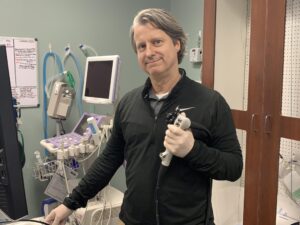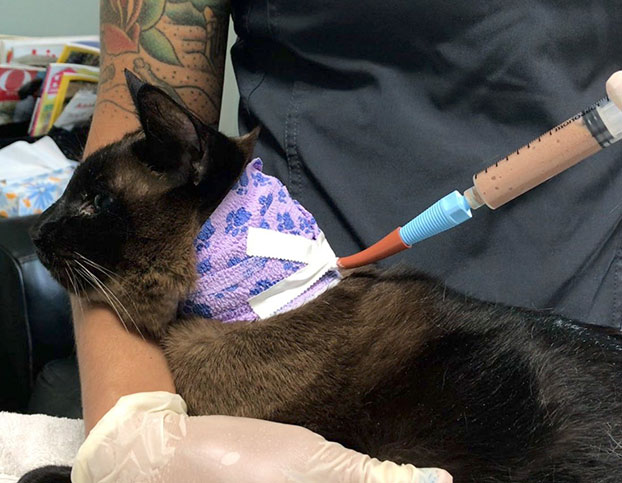When our beloved furry feline family member stops eating, it’s one of the most stressful things a pet owner can experience. A day or two of finickiness is a concern; a week is an emergency. While we can try tempting them with their favorite treats and different foods, sometimes a more direct approach is needed to ensure they receive the nutrition they need to heal. This is where an esophageal (or “E-tube”) feeding tube can become a lifesaver.
What is an Esophageal Feeding Tube?
An esophageal feeding tube is a soft, flexible rubber tube that is placed directly into the esophagus (the tube that connects the mouth to the stomach) through a small incision in the left side of the neck. It’s a reliable way to provide cats and even small dogs with the nutrients, medications, and water they need without forcing them to eat by mouth.
How are E-Tubes Placed?
The insertion of an E-tube is a relatively straightforward procedure which is perform regularly at Savannah Veterinary Internal Medicine. Your cat is placed under short anesthesia to ensure they are comfortable and still. A small (less than 1/4 of an inch) incision is made through the skin on the left side of the neck, and an instrument is used to create a tunnel under the skin and into the esophagus. The flexible tube is then threaded through this tunnel and into the esophagus, with the end of the tube ending up in the esophagus just before it enters the stomach. It is important that the end of the tube does not enter the stomach as this can cause nausea, vomiting and potentially acid reflux. At our clinic, we use endoscopy to visualize that placement of the tube is correct. The tube is then sutured to the skin around the area that the incision is made. The procedure is quick, your pet recovers from the anesthesia shortly after, and is able to go home with you to begin using the tube the same day.
Why Use an E-Tube? The Reasons Behind the Lifeline
There are many reasons we might recommend an E-tube, but they all boil down to one central goal: providing nutritional support to a patient who can’t or won’t eat on their own, essentially, their lifeline!
Anorexia (Lack of Appetite): This is the most common reason. Cats may stop eating for a variety of reasons, including pain, nausea, stress, anxiety or a specific disease.
Facial and Jaw Trauma: Cats with injuries to their mouth, jaw or head often cannot eat.
Feline Hepatic Lipidosis (Fatty Liver Disease): This is a serious medical condition in cats. When a cat (especially overweight) stops eating for even a few days, their body starts breaking down fat stores for energy. This fat clogs the liver, leading to dangerous and potentially fatal liver failure. The only way to reverse this process is to provide adequate, consistent nutritional support. An E-tube is the safest and most effective way to ensure they receive the calories they need to get their liver functioning normally again.
The Benefits of E-Tubes
Simply put, E-tubes can be life-saving. For any sick cat, getting proper nutrition is the way to recovery. These tubes allow you to deliver all the essential food and water your cat needs. This prevents serious issues like life-threatening malnutrition and liver failure, giving your cat’s body what it needs to fight off illness and heal.
Beyond just nutrition, we all know how tricky it can be to give medications to our feline friends, even when they’re healthy and eating normally. When a cat isn’t eating voluntarily, giving medicine becomes even more challenging. The great news is that medications can be administered right through the E-tube making the process much easier for both you and your cat.
Risks and Potential Complications
While E-tubes are generally very safe, no medical procedure is without risk. Potential complications are rare but can include:
Tube Dislodgment or Clogging: This is the most common issue and is easily managed by careful use of the tube.
Infection at the Insertion Site: Weekly neck bandage recheck is essential to prevent this.
Complications from Anesthesia: While anesthesia for E-tube placement is brief and low-risk, there is always a minimal risk with any anesthetic procedure.
Using the E-Tube: Feeding and Care
Once the tube is in place, the true work begins — at home! Before your pet goes home, we will spend as much time with you to be sure that you are comfortable and understand all the ins and outs of safe tube usage. We are very experienced with these tubes and we want you to feel comfortable before leaving with your pet! Don’t hesitate to ask our staff questions — and call if more arise when you get home!
Food Types: The diet used with an E-tube is specifically formulated for tube feeding. It’s a high-calorie, highly digestible liquid or slurry — think of watery pudding. These “recovery” or “critical care” canned diets are designed to provide maximum nutrition in a small volume and are thin enough to pass through the tube without clogging. You can never use regular canned food from the store in an E-tube, as it will be too thick.
Frequency of Feeding: Feeding is done in small, frequent meals throughout the day, just like a cat would naturally graze. This is crucial to avoid stomach upset. We will provide a detailed feeding schedule and the exact volume of food to give at each meal tailored specifically for your cat.
How to Feed: Using a syringe you attach to the tube, you’ll slowly flush the tube with a small amount of water first, then slowly inject the food, and finally flush it again with water. This “flush, feed, flush” technique ensures the tube remains clean and clear.
When the Tube Comes Out: The Final Step
When your cat is eating well on their own for at least one week, and we are confident they are no longer at risk of malnutrition and hepatic lipidosis, it’s time to remove the E-tube. This is the moment every pet owner waits for!
Fortunately, tube removal is incredibly simple and doesn’t require anesthesia. We simply clip the suture holding the tube in place and gently slide the tube out. The small hole in the neck will heal on its own within a week or so.
We never want to remove the tube until we are absolutely sure that your pet is going to continue eating. Remember: It’s easy to take it out, but much more complicated to put it back in.
Esophageal feeding tubes are a valuable part of feline healthcare, offering a safe and effective way to nourish our sickest patients and give them the best possible chance at a full recovery. If your veterinarian recommends an E-tube, you can rest assured it’s with your pet’s best interest at heart. If you have questions about e-tubes, if your cat is not eating, or you have other concerns about your furry buddies, contact us, we are happy to help.

Author:
James Woods DVM, MS, DACVIM (SAIM)
Ph: (912) 721-6410
Contact Us
